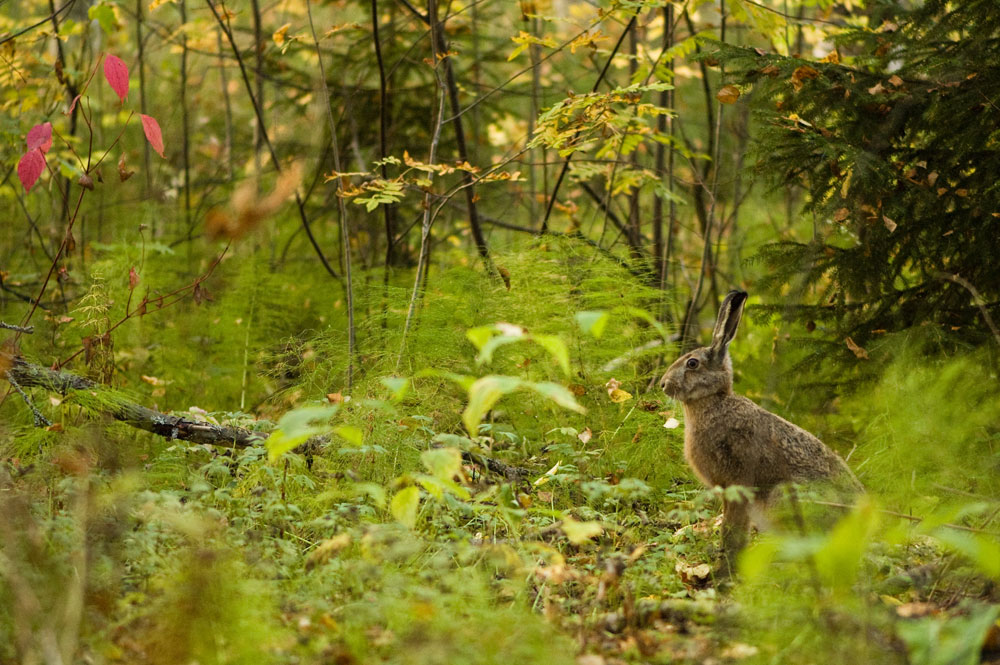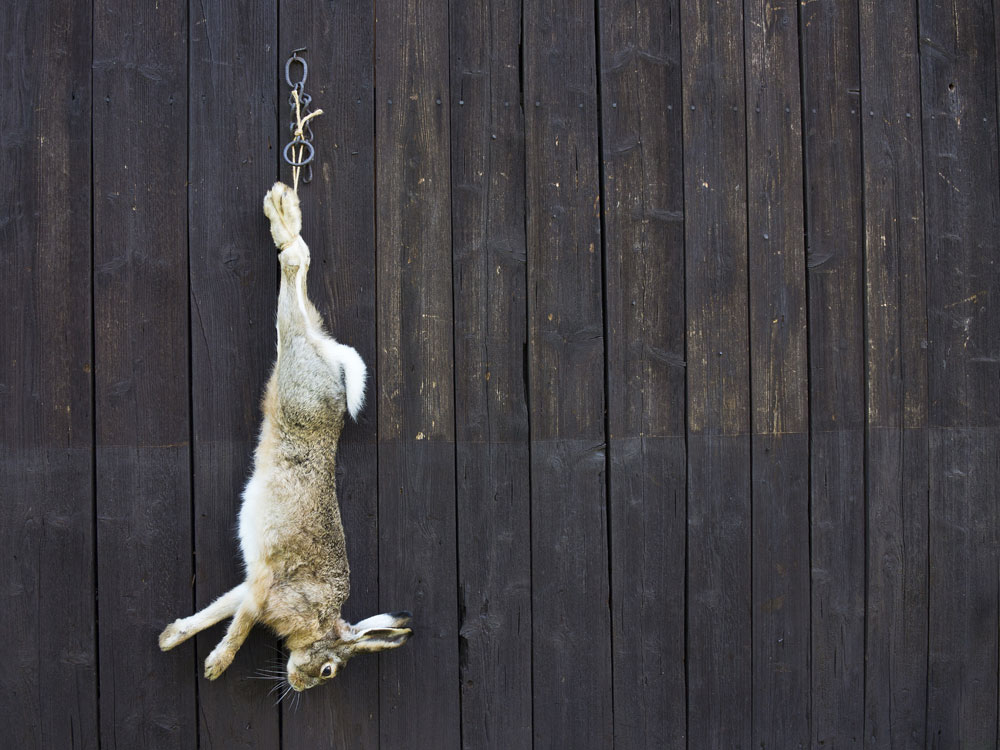After deer season closes, rabbit hunting offers up an exciting pastime in the winter months. It's a different rush from the explosion of grouse hunting or the majesty of flushing a mallard at dawn, but rabbit hunting has its particular draws.
Rabbit hunting is a new kind of challenge, and a fun one, for many hunters. The burst of brown fur out of the underbrush, followed by the fluid movement of your rifle, spurs adrenaline through your body.
Rabbits are plentiful, so, if you find them, you can usually put a few away for future meals of yummy rabbit stew. It's a great way to get novice hunters and youngsters out there, especially in a season that doesn't have too many options for hunting.
You don't need a pack of dogs to go rabbit hunting; you can head out on a solo hunt with a single shot and a pocketful of shells and be just as successful. By studying rabbits' defensive strategies, understanding their hiding places, and being patient, you'll be well on your way to bagging a few cottontails.

1. Know Rabbit Habits
The rabbit is the quintessential prey animal—a wary, timid herbivore. As with all prey animals, it has its own set of defensive tactics.
First, the rabbit tries to hide from you. A rabbit's first instinct when it senses a predator is freezing and blending in with the surrounding vegetation. Depending on the terrain, you should try to flush it out.
When possible, try to make noise in one part of the brush to flush the animal out in front of you. Walking zig-zag across a field can also scare up any rabbits hiding among the twists and whorls of grass.
If the rabbit is kicked up with a line of escape heading away from you, it will zig-zag in leaps to shake you. One of the rabbits' defensive measures is this random pattern of running.
Rabbits used to be more diurnal in their habits; however, encroaching agricultural practices like edging borders and trimming brushy areas has reduced their habitat. They tend to be more active during the early mornings and evenings to increase their chances of survival.
2. Find a Rabbit Habitat
Brambly, brushy areas that are close to their feeding areas are excellent prospective hunting grounds for cottontails. Abandoned barns often provide the cover they crave, as well as hollow logs, fence rows, deadfall, or brush piles.
Since they're wary and wily, it's often easier to locate them by finding their favorite foods; clover, alfalfa, and blackberry bushes are just a few cottontail favorites. They love to sit by fences and at the edges of where fields blend into forests.
3. Put on the Right Gear
One way to find rabbits' habitat is to go out at dawn or dusk and note where you see any rabbits disappear into the brush. In the winter, these times of day can be especially chilly.
If you're planning a hunting trip, bring along the proper equipment like a blaze orange safety vest, thick clothing, and boots. Bring heavy-duty work gloves, as rabbit territory often teems with thickets, tangles, and thorny brush.

4. Match Your Firearm to Your Prey
You don't want to find the right habitat at the right time of day, flush the rabbit, and take the shot, only to have your quarry disappear into a pile of fluff because you're using the wrong caliber firearm. In other words, you don't want to completely eradicate your prey with too much firepower.
When you're hunting small game, you need to match your weapon to your prey. Most rabbit hunters go for a 20-gauge shotgun with an improved cylinder choke. Any larger, and you won't take down your quarry, you'll obliterate it.
Another popular choice for rabbits is a .22 rifle, great at a distance, and you can also try a 12- or a 16-gauge shotgun, using 5 to 7.5 shells.
You can also use a bow and arrows, and crossbows are popular. Skip the pistol.
If you're going to make a rabbit stew with your prize, use a shot that is non-lead to avoid potential lead-poisoning hazards.
5. Be Vigilant
As you're walking through the low-lying brushy areas, be observant of rabbit droppings, which are small (about the size of blueberries) and round and amassed in small piles.
Walk into the wind, working a field upwind so your scent and any noises you're making are carried away from your flighty prey.
One trick that works equally with grouse or woodcock as it does with rabbit is to weave a long pause into your walk. If you're zig-zagging through likely rabbit habitat, pause every so often. Wait there, still and silent, for up to half a minute.
Rabbits are incredible listeners and have probably heard you from a ways off. When you pause, they think you've spotted them, and, if you wait long enough, they may flush on their own, escaping a perceived threat.
6. Check the Weather
A lot of hunters go out for rabbits in the winter months. As with any animal, rabbits' habits change as the seasons come and go. If you're out on a very frigid day, you'll have to flush your prey from their hiding holes where they're keeping warm.
If it's sunny and slightly warmer, especially after a cold snap, you may be able to find rabbits active during the day, instead of just evening and morning hours. Check a south- or southwestern-facing slope in the middle of a warmer day for rabbits sunning themselves to raise their internal temperature.
Dressing and Cooking
When you’ve bagged your rabbit, you need to dress it before cooking. Dressing is a relatively simple procedure, and there are a lot of different ways to do it. Remember that wild rabbits often have a lot of fleas, so dress your rabbit outdoors or let it cool completely before you bring it inside. A lot of hunters dress their rabbits on-site to reduce the amount of weight they carry back.
The easiest is to make an incision from anus to breastbone and open the rib cavity. First, remove the windpipe and esophagus, and continue to remove all the entrails. Always remove the anal glands and the gall bladder, along with the rest of the innards. Pat the inside of the carcass dry and let it cool for at least two days for tender meat.
You can eat rabbit in a variety of ways, but most people like it in a stew. Braise it first to add that lovely, umami taste of roasted meat to your stew.
To butcher a rabbit and cut it up in the easiest way, start from the ground up. First, cut off the hind legs, which is easy as the legs are not connected to the body by bone. Do this again for the front legs, and the same for the head and the ribcage, removing them and any unattractive sinew or silver skin (some make paté from these trimmings).
You’re left with a saddle of meat, which you can cut into two by severing the backbone. You can then chop these pieces into smaller, bite-sized bits.
Wild rabbit has a lovely, gamey taste that makes it many hunters’ favorite meat to bring home and cook.

Final Thoughts
In rabbit hunting, patience is your watchword. These wary creatures are timid and sensitive. They're challenging to find and flush, give you an adrenaline burst when they bolt from the brush, and you can usually pick up a few if you've chosen the right area.
Hunting rabbits on a beautiful winter's day is an experience every hunter should have at least once. To learn more about all things rabbit hunting, visit Mossy Oak, a site curated for hunters by hunters.






























